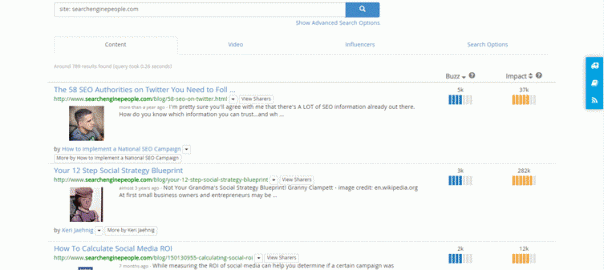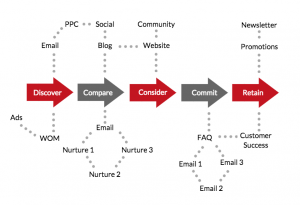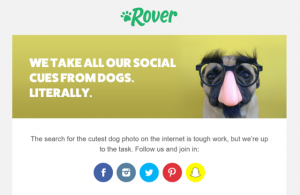
Do people really care about your content? It used to be that you could tell how people felt because they would tell you by commenting on your blog, but many blogs find that comments are declining and even turn comments off altogether. But now people are interacting with content in a variety of places, and that means you need to data from those places to measure engagement on your content.
In addition, knowing what people like and find interesting can help guide your content and social media strategy so you keep your audience engaged. Here are several tools you can use to do that.
Social Media Analytics Tools
A good place to start is with the analytics tools provided by social sites themselves. If you’re particularly active on a single social media site, this could be the right approach for you.
1. Twitter Analytics
Twitter has its own analytics tool. You can get to it via the dropdown menu when you click on your profile picture, or via the analytics.twitter.com website. Log in with your Twitter account to turn the analytics function on and see data about account activity over the past 28 days.

The dashboard gives an overview and you can dig into the top navigation menu to get more data on tweets, impressions, profile visits, mentions, followers, and tweets linking to you. While the detail is limited, you can figure out at a glance whether more people are visiting your Twitter profile, mentioning or linking to you and whether your follower numbers are going up, and there’s some great demographic information to help with content targeting.
2. Facebook Insights
The Facebook Insights tool can also help with content engagement tracking. Not only does the overview panel give you data on likes, post reach and engagement (Facebook looks at likes, comments, shares and clicks) but you can click on each chart for more detail.
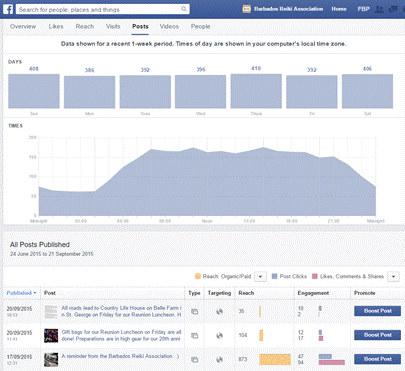
The most useful part for tracking content engagement is the “posts” submenu, which lets you track post activity over the previous six months. The colorful charts make it easy to see at a glance which of your posts has done best so that you can pull out some similarities and use that to guide your future content strategy.
3. Pinterest Analytics
Pinterest gives you a wealth of data both on your Pinterest profile and, if you have linked it to your site, on content pinned from your site. For each of those you can click through for more detail and to refine the period under review.
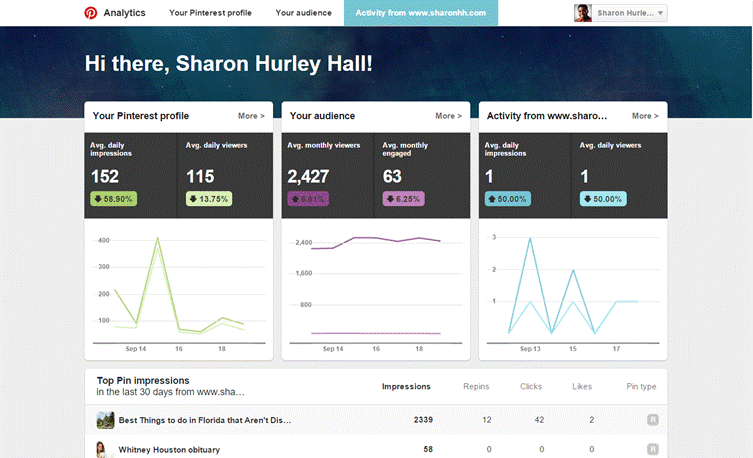
One cool and interesting feature is the ability to see how people are engaging with your content. Knowing whether they are using a mobile app or browsing on the web and knowing whether people are pinning content straight from your site or repinning content others have found can be helpful. There’s even data on your most shared pins, best pins in terms of performance in search and power pins which get repins, clicks and more to help you get more from your Pinterest strategy.
4. Slideshare Analytics
Linkedin Slideshare provides insights into views, actions, viewers and social shares, giving you a useful overview of how your content performs there.
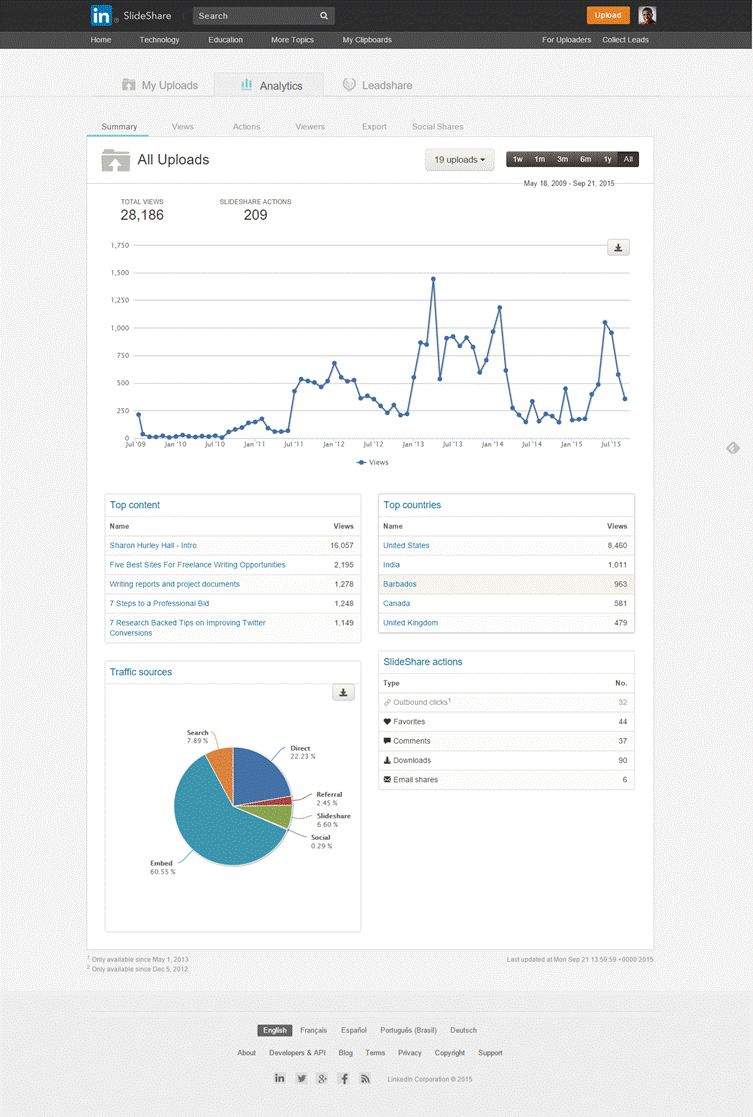
In terms of engagement, the most useful part of the report is the Slideshare Actions section which allows you to track clicks, favorites, comments, downloads and email shares. If someone is commenting, downloading or emailing your presentation, it’s a sure sign that they’re engaged. You’ll have to check out the analytics for individual presentations to get more data on comments and social shares.
5. YouTube
It’s hardly surprising that YouTube has in-depth analytics. After all, analytics is one of the things Google does very well. If you’re interested in engagement, the data on the number of minutes watched and the average view duration can help guide you in creating new content. (If people usually watch a minute and a half, there’s no point in creating a 10 minute video.)
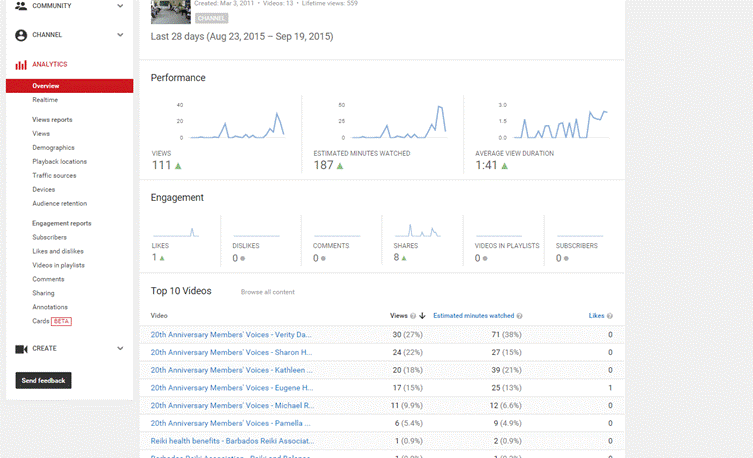
Scroll down the sidebar menu and you can explore additional data on views, demographics, playback and retention, as well as engagement reports covering likes, playlists, comments, annotations and more.
6. Google+ (Sorta)
Google’s been busy dismantling Google+ and one of the casualties has been Ripples. That engagement tracking tool has disappeared from personal profiles. However, if you have a business page, visiting Google My Business will give you information on visibility, engagement and audience.
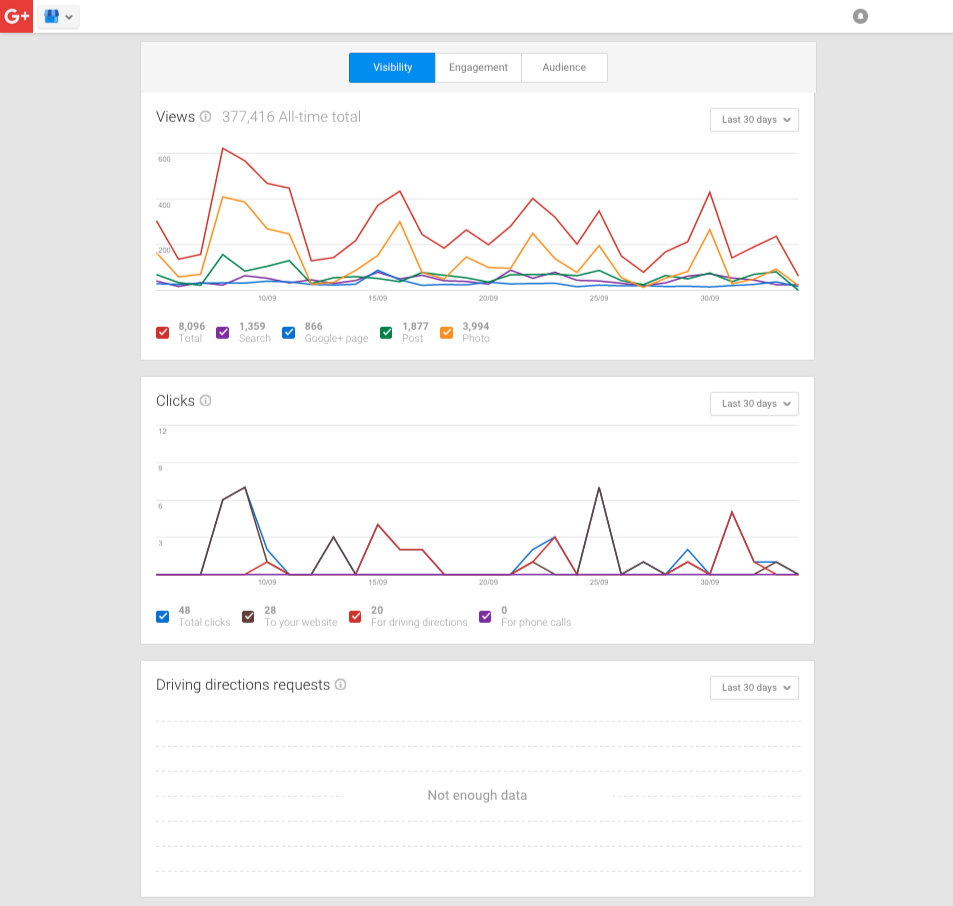
The engagement part of the dashboard tells you more about actions on posts, what’s happened on recent posts and what the breakdown of actions is (+1s,shares and comments).
5 Tools You Shouldn’t Miss
If you want to look beyond the individual sites, there are many other tools you can use. Here’s a selection.
7. Google Analytics
Google Analytics provides multiple ways for you track content engagement:

- Go to Behavior – Site Content – All Pages to see the most popular pages on your site, then click on the links to individual pages to get more information on pageviews, time on page and more.
- Go to Acquisition – Social – Overview to see where your content is shared most. then click on the links to the social sites to see which URLs are being shared.
- Go to Audience – Users Flow to get a visual representation of how people are moving through your site and where you are losing them.
- Use this Google Analytics custom report to find out who’s reading your content all the way to the end.
8. SumoMe
I may be biased, but SumoMe is one of the best things I’ve installed on my website in a while. It’s got a couple of tools that help with content engagement tracking. First, there’s the heatmap, which shows what the hot areas of my site are. If I know where people are looking and clicking, I know what interests them.

Second, there’s the reading chart, which shows how many visitors read all the way to the end of a given page – another indicator of engagement. If most visitors drop off high up the page, you have a problem.
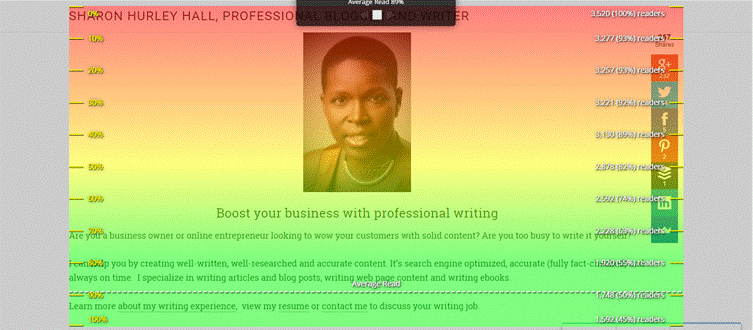
To enable both these tools, create a SumoMe account, install the plugin and add the functions you want. Then visit individual pages and click on the relevant icon to start tracking for each page.
9. BuzzSumo
If you read my post on content promotion, you’ll know that I’m a bit of a BuzzSumo evangelist(no, they’re not paying me). So it shouldn’t be surprising that BuzzSumo is one of my favorite tools for tracking content engagement.
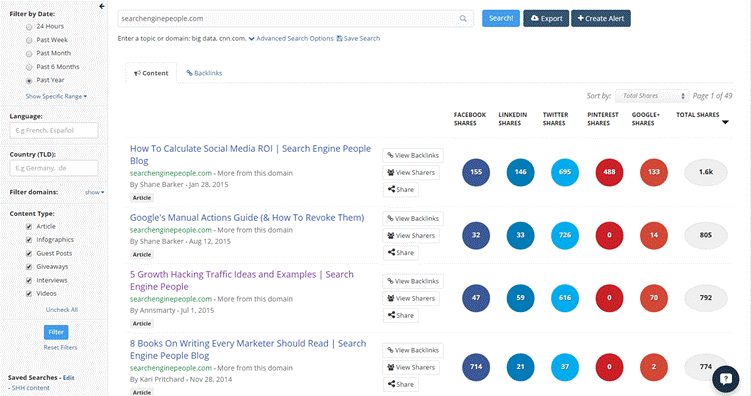
To use it, type in the name of your site, hit enter and you’ll get a list of the most socially shared posts over a period ranging from the last day to the last year. You can also find out who’s shared your content and, if you’re using the Pro version, who’s linked to it. Use this information as a starting point for building more engaging content.
10. Impactana
A new tool I found via Kristi Hines goes beyond Buzzsumo. It’s called Impactana and it doesn’t just measure social shares, but actual engagement.
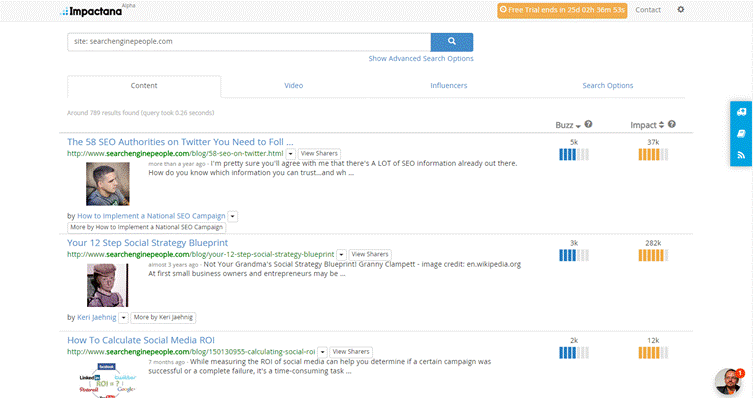
Use the “site:” operator to search for the most engaging content on your site, then sort by “buzz” or “impact”. Click either of those to see more information. The “impact” score includes backlinks, clicks, views, comments and more – everything you need to tell you whether a piece of content is really successful or not.
11. Contently Analytics
I wasn’t able to test Contently Analytics, but here’s what it has to offer.
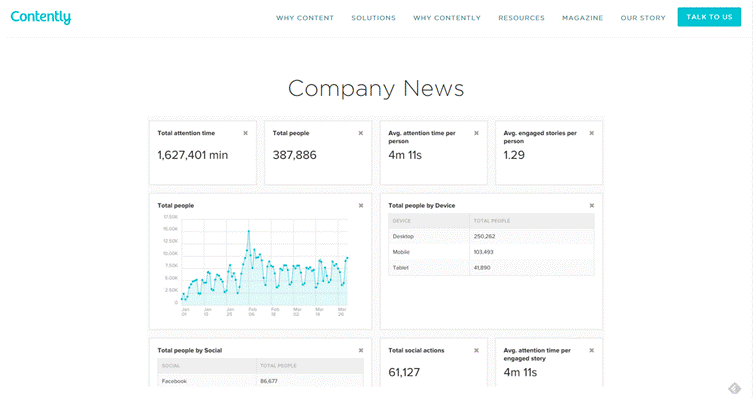
In addition to tracking a wide range of data, one important focus is attention. You can see the total attention time for your content, the number of people looking at it, the average attention time, the average number of stories people have engaged with, the number of social actions and much more. This looks like a great tool for anyone using the Contently platform for publishing.
Other Tools
These tools aside, there are other tools that include engagement statistics. Depending on your own setup you could try:
- Data from your email service provider. This varies in depth depending on the provider you use, but you can find out about opens and clicks and can usually integrate another analytics tool to deepen your insight.
- Most social sharing plugins include engagement tracking. Again, this varies with the plugin but you should be able to see where your content is being shared and follow this up with another tool. Popular plugins include AddThis, ShareThis,and SumoMe.
- If you’re using WordPress, you can use a range of plugins to track engagement. Some popular options include Google Analytics for WordPress by Yoast, and JetPack.
- Many social media dashboards bring together data from a number of sites to give you an overview of what’s going on with your content. There are many, many dashboards, but some popular tools in this space include HootSuite, Commun.it, Sprout Social, RavenTools, SumAll and Cyfe.
With so many tools to choose from, it’s not difficult to create the perfect engagement tracking setup for your content. Over to you: what tools would you add to this list?
Now Read:
- Use Google Analytics To Track These 3 Metrics For Your Content & Predict Your Next Big Win
- 7 Tips To Help You Boost Your Content On LinkedIn
- 10 Priceless & Powerful Content Curation Tools
Next Steps:
- Use Google Analytics To Track These 3 Metrics For Your Content & Predict Your Next Big Win
- 7 Tips To Help You Boost Your Content On LinkedIn
- 10 Priceless & Powerful Content Curation Tools
Hand-Picked Related Articles:
- Use Google Analytics To Track These 3 Metrics For Your Content & Predict Your Next Big Win
- 7 Tips To Help You Boost Your Content On LinkedIn
- 10 Priceless & Powerful Content Curation Tools
* Lead image adapted from Enokson
11+ Tools To Track Content Engagement
The post 11+ Tools To Track Content Engagement appeared first on Search Engine People Blog.
(170)
